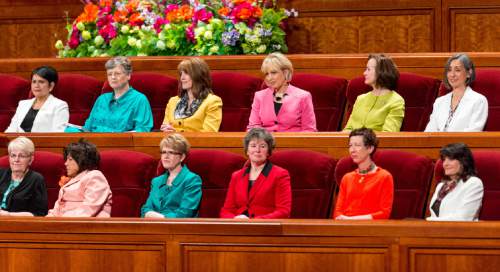This is an archived article that was published on sltrib.com in 2015, and information in the article may be outdated. It is provided only for personal research purposes and may not be reprinted.
Three top Mormon women officers were added this week to high level, previously all-male LDS Church councils, which oversee budgets, curriculum, missionary work, temple rites and family history.
But church spokeswoman Kristen Howey has confirmed that at least one significant panel remains exclusively male: the Correlation Executive Committee.
The Church of Jesus Christ of Latter-day Saints' top decision-making body is made up of the three-member First Presidency and Quorum of the Twelve Apostles — by definition, all males.
That group approves policy and doctrine, while overseeing the three primary councils (Priesthood and Family, Missionary, and Temple and Family History) that now include the following female officers: Relief Society President Linda K. Burton, Young Women President Bonnie L. Oscarson and Primary President Rosemary M. Wixom.
The Correlation Executive Committee is among many in the third tier of committees and includes two Mormon apostles, other LDS general authorities (males) and some male staffers. No women.
This team evaluates manuals, hymns, software and other materials disseminated to the faith's members — basically, anything with an LDS Church logo. The Utah-based church's Correlation Department includes staffers who are responsible for the evaluation process. These staffers — some of whom are women — submit their work and recommendations to the executive committee.
Howey has noted that "there are literally dozens of church committees," and that "women serve on many of them."
Having women permanently seated on such councils is "certainly an improvement over having men meet alone and solicit female feedback only when they happen to realize that it is needed," blogger April Young Bennett writes at Exponent II, a long-standing magazine for Mormon women. "Feedback is not enough because it excludes women from bringing in ideas at the beginning of the process and participating in final decision making."
It has, however, taken decades for such women-friendly changes to be made.
Chieko Okazaki, who was a first counselor in the General Relief Society presidency from 1990 until 1997, reported that group wanted to join top committees but was rebuffed.
"We asked one time if we could be on the building committee and the temple committee, because sometimes we think, 'Why did they build it this way?'— because it doesn't work very well for the women's needs," Okazaki said in a 2005 interview in Dialogue: A Journal of Mormon Thought. "And we wanted to be on the temple committee, because there are many things that affect women in the temple. But we were never allowed to be a part of those committees."
The hope now, Bennett writes, is that "barriers have been broken and eventually all male-only Mormon councils and quorums will welcome female members."
V.H. Cassler, an LDS professor in Texas, believes a roadblock has indeed been removed.
Putting women on "three general priesthood councils" gives them "greater influence," Cassler writes in the online Mormon magazine SquareTwo, "than the two committees on which women have served in the past, the General Welfare Committee and the Executive Welfare Committee."
She notes that women also were on the LDS Church Educational System's board of trustees.
"In a way ... our faith community has taken an irrevocable step towards the diarchy that characterizes the order of heaven," Cassler adds. "Women are not 'auxiliaries' in that order."
Once taken, "this first step cannot be undone," she says. "It will no longer be possible to exclude women from ... councils — now understood to be priesthood councils — on the basis of their sex."
That wall, Cassler writes, "has been shattered forever."
Twitter: @religiongal





